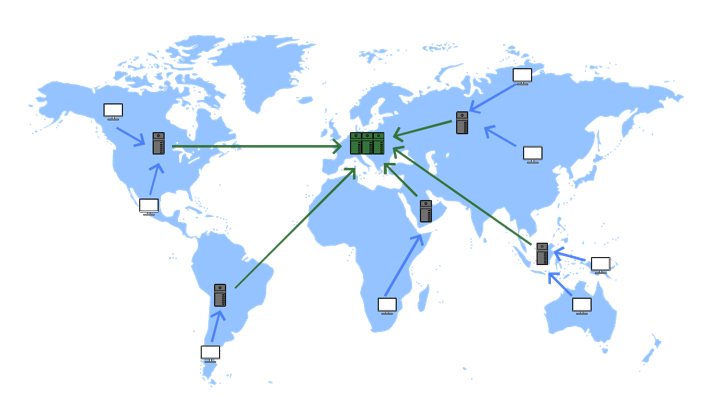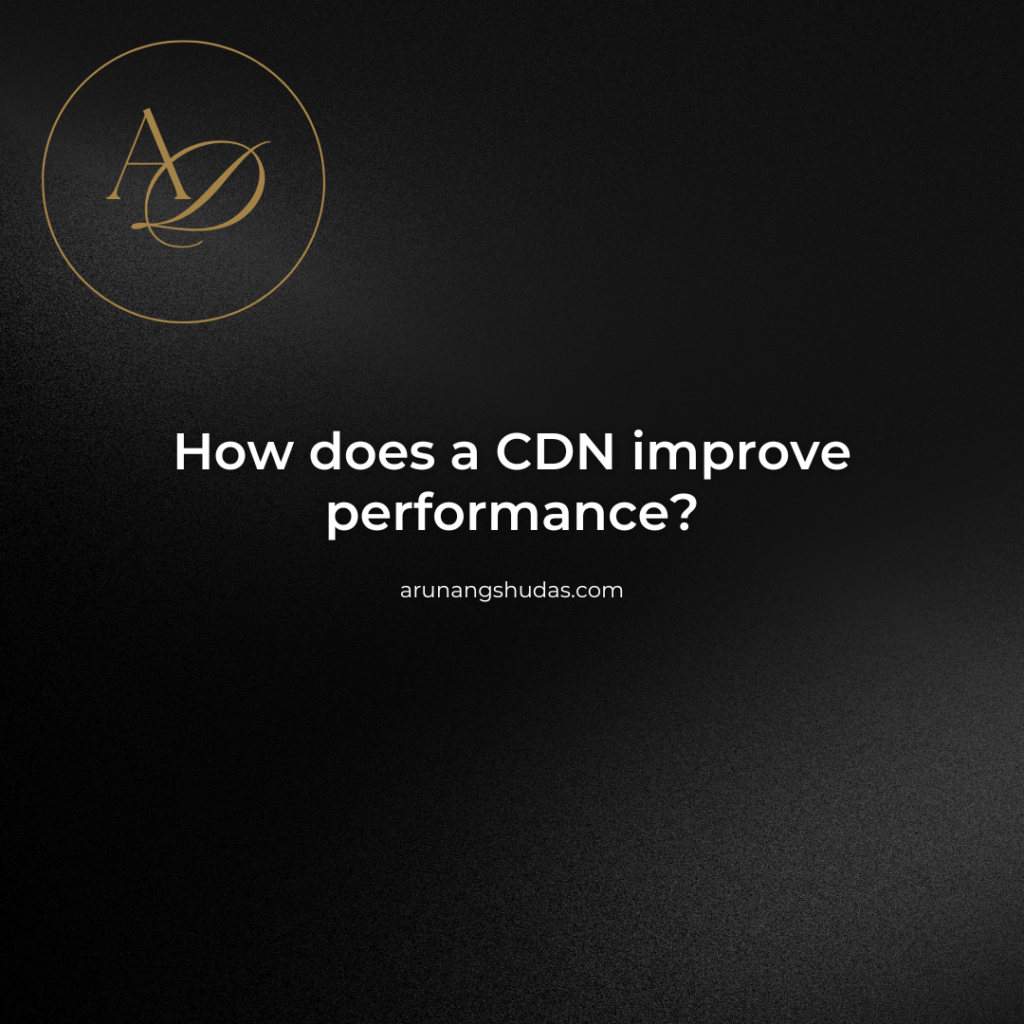A Content Delivery Network (CDN) is a powerful tool for improving website performance, reliability, and user experience. In the digital age, where speed and seamless user interactions are critical, understanding how CDNs work and how they benefit web performance can be invaluable for businesses and website owners.
What is a Content Delivery Network (CDN)?

A CDN is a network of distributed servers located across various geographic locations. The primary function of a CDN is to deliver content, including HTML pages, JavaScript files, stylesheets, images, and videos, to users based on their geographical location. By reducing the physical distance between the server and the user, CDNs improve loading speeds and reduce the load on the origin server, thus optimizing the overall web experience.
How Does a CDN Work?
To understand how a CDN boosts performance, let’s take a closer look at the mechanisms involved in delivering content.
Edge Servers and Points of Presence (PoPs): CDNs consist of multiple servers, known as “edge servers,” strategically located in Points of Presence (PoPs) around the globe. When a user requests a web page or a specific piece of content, the CDN directs that request to the nearest edge server, ensuring faster data delivery.
Caching: CDNs cache static content on edge servers, storing frequently requested data locally for faster access. This means that when a user requests content that has already been cached on an edge server, the request doesn’t need to travel all the way to the origin server, significantly reducing latency and improving speed.
Intelligent Routing: CDNs use algorithms to determine the most efficient path to deliver content. These algorithms consider factors like server load, network conditions, and latency to ensure that data reaches the user as quickly and smoothly as possible.
Load Balancing: By distributing incoming traffic across multiple servers, CDNs prevent any single server from becoming overwhelmed, ensuring consistent performance even during peak traffic times. Load balancing helps to maintain reliability and speed, which is particularly important for websites with high visitor counts.
How CDNs Improve Web Performance

1. Reduced Latency
Latency is the delay that occurs when data is transmitted from the server to the user’s device. With a traditional server setup, users located far from the origin server experience higher latency because of the physical distance. CDNs solve this problem by serving content from an edge server closer to the user. This proximity reduces the round-trip time (RTT), allowing data to be delivered more quickly and minimizing latency.
For instance, if a user in Europe tries to access content hosted on a server in the United States, they may experience higher latency. However, with a CDN, the content is served from a nearby server, resulting in faster load times and a smoother browsing experience.
2. Efficient Resource Utilization
CDNs cache content at the edge servers, taking the load off the origin server. This reduces the number of requests that the origin server has to handle, making it more efficient and capable of managing other tasks. For high-traffic websites, this reduction in server load can be substantial, preventing potential slowdowns and allowing resources to be allocated to more dynamic requests that may not be cached.
By offloading the majority of requests to edge servers, CDNs also help prevent server overloads during traffic spikes, such as product launches or seasonal sales. This capability is crucial for e-commerce platforms, streaming services, and social media websites where traffic can fluctuate greatly.
3. Enhanced Load Balancing
Load balancing distributes traffic evenly across multiple servers, which helps to avoid bottlenecks and reduce the risk of downtime. Most CDNs have load-balancing capabilities built in, meaning they can distribute user requests to different servers based on server availability, location, and load. This redundancy ensures that if one server experiences an issue, another server can pick up the load, ensuring that users experience minimal disruption.
For example, during high-traffic events like streaming a major sporting event, CDNs can distribute requests efficiently, ensuring smooth delivery even if traffic surges unexpectedly.
4. Improved Reliability and Resilience
By spreading content across multiple locations, CDNs enhance reliability. If an edge server goes offline due to maintenance or technical issues, the CDN can reroute traffic to another nearby server, minimizing the impact on users. This redundancy helps to ensure that users can still access content even if part of the CDN infrastructure is down.
Additionally, CDNs provide protection against Distributed Denial of Service (DDoS) attacks by absorbing large amounts of traffic that would otherwise overwhelm the origin server. Many CDNs are equipped with security measures that can filter out malicious traffic, protecting websites from such attacks.
5. Faster Load Times for Static and Dynamic Content
CDNs can significantly speed up the delivery of both static and dynamic content:
- Static Content: Static content (e.g., images, CSS, JavaScript) is easily cached by CDNs. Once cached, this content is served directly from the edge server, reducing the need to fetch it from the origin server repeatedly.
- Dynamic Content: While dynamic content, which changes based on user interactions, is more challenging to cache, some advanced CDNs employ techniques like “dynamic caching” or “edge computing.” These approaches can cache portions of dynamic content or process requests closer to the user, speeding up the response time for interactive and personalized content.
This improvement is particularly beneficial for e-commerce websites, which often contain a mix of static and dynamic elements that need to load quickly to retain user engagement.
6. Better Mobile Experience
Mobile devices are highly sensitive to performance issues, especially on slower networks. CDNs can help optimize the mobile experience by delivering content from the nearest edge server, improving load times, and reducing data transfer delays. Some CDNs even offer mobile-specific optimizations, like adaptive image delivery, which adjusts image quality based on network conditions to ensure faster loading on mobile devices.
With the rapid growth of mobile users worldwide, optimizing for mobile performance is essential for any website or application, and a CDN can be a key component in achieving that goal.
7. Global Reach and Improved SEO
With servers in numerous geographic locations, CDNs make it easier for businesses to reach a global audience. Faster load times improve user satisfaction, and search engines like Google consider site speed an important factor in ranking. Therefore, by improving load times, CDNs can positively impact SEO, helping websites rank higher in search engine results pages (SERPs).
When users in various parts of the world can access a website quickly, bounce rates decrease, and time-on-page metrics improve, which can further enhance SEO performance. For websites that rely on search engine traffic, this can translate into greater visibility and increased revenue.
Key Takeaways on CDN Benefits
- Reduced Latency: Brings content closer to users, minimizing the delay in data transmission.
- Efficient Resource Utilization: Offloads traffic from the origin server, reducing server load and enhancing performance.
- Enhanced Load Balancing: Distributes traffic across multiple servers, preventing bottlenecks and maintaining uptime.
- Improved Reliability and Resilience: Increases uptime and provides protection against server outages and DDoS attacks.
- Faster Load Times for Static and Dynamic Content: Optimizes content delivery for both types of content, boosting site speed.
- Better Mobile Experience: Delivers content optimized for mobile, enhancing user experience on handheld devices.
- Global Reach and Improved SEO: Ensures fast access worldwide, contributing to improved SEO rankings.
Conclusion
A CDN is an essential tool for modern websites, offering numerous benefits for improving performance, reliability, and user experience. By caching content, balancing load, and using intelligent routing, CDNs reduce latency, accelerate load times, and optimize resources. For websites aiming to reach a global audience, a CDN not only enhances performance but also strengthens SEO, making it a valuable investment.
Incorporating a CDN can be particularly transformative for websites with high traffic, large multimedia assets, or a global user base. As web users increasingly expect fast and smooth interactions, using a CDN can be a decisive factor in meeting those expectations and providing a top-tier digital experience.




